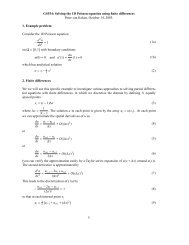Governing equations
Governing equations
Governing equations
You also want an ePaper? Increase the reach of your titles
YUMPU automatically turns print PDFs into web optimized ePapers that Google loves.
Equations for compressible mantle convection<br />
With the Sepran finite element package we solve the governing <strong>equations</strong> for compressible mantle<br />
convection in the Truncated Anelastic Liquid Approximation (TALA) which are simplified from<br />
the full <strong>equations</strong> of a compressible fluid. The derivation of the <strong>equations</strong> follows the treatment<br />
in Chapter 6 of Schubert, Turcotte and Olson (2001). The relevant <strong>equations</strong> from this book are<br />
indicated.<br />
First, the general dimensional <strong>equations</strong> for a compressible fluid are as follows. Mass conservation<br />
is given by (6.2.1):<br />
∂ρ<br />
∂t +∇⋅ρu = 0<br />
where ρ is density, t is time, and u is velocity.<br />
The Navier-Stokes <strong>equations</strong> for conservation of momentum are given by (6.5.7):<br />
ρ Du =−∇P +∇⋅τ +ρg<br />
Dt<br />
where P is pressure, g is gravity and τ is the deviatoric stress tensor is given by (6.5.6)<br />
τ=2μ˙ε =μ(∇u +∇u T ) − 2 3 μ∇ ⋅ uδ ij<br />
where μ is the dynamic viscosity and ˙ε is the strain-rate tensor. It is assumed that the bulk viscosity<br />
of the fluid is zero.<br />
The conservation of energy is given by (6.9.7):<br />
DT<br />
ρc p −αT DP =∇⋅(k∇T ) +φ +ρH<br />
(4a)<br />
Dt Dt<br />
where c p is heat capacity at constant pressure, α is thermal expansivity, k is thermal conductivity,<br />
H is the volumetric heat production. The viscous dissipation φ is given by<br />
(1)<br />
(2)<br />
(3)<br />
φ= 1 2 τ : ˙ε = τ ∂u i<br />
ij<br />
∂x j<br />
(4b)<br />
Equations under the Anelastic Liquid Approximation (ALA)<br />
We assume a reference state with<br />
ρ=ρ(T, p) +ρ′<br />
T = T + T′<br />
(5)<br />
P = p + p′<br />
where the quantities T , p and ρ are independent of time and a function of depth only. The reference<br />
pressure is given by the hydrostatic pressure<br />
∇ p = ρg<br />
(6)<br />
We non-dimensionalize the <strong>equations</strong> using reference values for density ρ r , expansivity α r , temperature<br />
contrast ΔT r , conductivity k r , heat capacity c pr<br />
, bulk modulus K sr<br />
, depth of the convecting<br />
layer b and viscosity μ r . The non-dimensionalization for velocity u r , pressure p r and time t r
follow as<br />
u r =<br />
k r<br />
ρ r c pr<br />
b<br />
, p r = μ r k r<br />
ρ r c pr<br />
b 2 , t r = ρ rc pr<br />
b 2<br />
k r<br />
(7)<br />
The non-dimensionalization of temperature introduces the dimensional surface temperature T 0<br />
through T * = (T − T 0 )/ΔT r where the * indicates a non-dimensional quantity. The non-dimensional<br />
ratio T 0 * = T 0 /ΔT r enters the heat equation as indicated below if T * = 0 is prescribed at the<br />
surface. The non-dimensionalization introduces the non-dimensional Prandtl number Pr, Mach<br />
number M, dissipation number Di, Rayleigh number Ra and relative volume change due to temperature<br />
ε=αΔT r . We use the further assumptions that the fluid is anelastic M 2 Pr
Equations for the TALA<br />
The non-dimensional <strong>equations</strong> for the truncated anelastic liquid approximation are given by (8),<br />
(9) and (10) with the further assumption that the pressure dependence of buoyancy (second term<br />
on right hand side of (9a)) can be ignored.<br />
Equations used to simulate the models of Jarvis and McKenzie (1980)<br />
Jarvis and McKenzie (1980) assume that all thermodynamic variables are constant (α =1, K S = 1,<br />
c p = 1, g = (0,1) T , k = 1, except for density which is given by ρ=exp Diz and that the models<br />
γ r<br />
are strictly bottom heated (H = 0). The discussion on page 533 near equation 51 of Jarvis &<br />
McKenzie (1980) implies the TALA is used. The non-dimensional <strong>equations</strong> are then simplified<br />
in terms of potential temperature T = T′ to<br />
∇⋅ρu = 0<br />
(12)<br />
0 =−∇p′ −ρRaTẑ +∇⋅τ<br />
(13)<br />
ρ DT + Diρw(T + T (14)<br />
Dt<br />
0 ) =∇ 2 T + Di<br />
Ra φ+∇2 T<br />
where w is the upward component of velocity. Note that these <strong>equations</strong> are equivalent to those<br />
in Jarvis and McKenzie (1980) only if it is assumed that ∇ 2 T → 0. An equivalent set of <strong>equations</strong><br />
can be derived if we assume total temperature T = T + T′ which yields<br />
∇⋅ρu = 0<br />
(15)<br />
0 =−∇p′ −ρRa(T − T)ẑ +∇⋅τ<br />
(16)<br />
ρ DT + Diρw(T + T (17)<br />
Dt<br />
0 ) =∇ 2 T + Di<br />
Ra φ<br />
These <strong>equations</strong> are equivalent to those in Jarvis and McKenzie (1980) if it is assumed that<br />
T → 0.<br />
Simplified <strong>equations</strong>: EBA<br />
The extended Boussinesq approximation (EBA) is based on (8)-(10) with the further assumptions<br />
that density ρ=1. This leads to<br />
∇⋅u = 0<br />
(18)<br />
0 =−∇p − RaTẑ +∇⋅τ<br />
(19)<br />
DT<br />
Dt<br />
+ Diw(T + T 0 ) =∇⋅(k∇T ) + Di<br />
Ra φ+H<br />
(20)
Simplified <strong>equations</strong>: BA<br />
The Boussinesq approximation further ignores all terms proportional to Di:<br />
∇⋅u = 0<br />
0 =−∇p − RaTẑ +∇⋅τ<br />
(21)<br />
(22)<br />
DT<br />
Dt<br />
=∇⋅(k∇T ) + H<br />
(23)<br />
References<br />
Jarvis, G.T., and D.P. McKenzie, Convection in a compressible fluid with infinite Prandtl number,<br />
J. Fluid Mech., 96, 515-583, 1980.<br />
Schubert, G., D.L. Turcotte, and P. Olson, Mantle convection in the Earth and Planets, Cambridge<br />
University Press, 2001.















